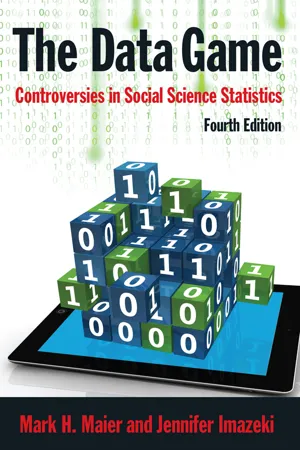Economics
National Economy
The national economy refers to the economic activities and financial interactions within a specific country. It encompasses the production, consumption, and distribution of goods and services, as well as the overall economic health and performance of the country. Factors such as employment rates, inflation, and government policies all play a role in shaping the national economy.
Written by Perlego with AI-assistance
Related key terms
9 Key excerpts on "National Economy"
- eBook - ePub
The Macroeconomic Environment of Business
Core Concepts and Curious Connections
- Maurice D Levi(Author)
- 2014(Publication Date)
- WSPC(Publisher)
CHAPTER 1 NATIONAL INCOME AND NATIONAL PRODUCT“Every short statement about economics is misleading (with the possible exception of my present one).”Alfred MarshallKey Concepts: Domain of macroeconomics versus microeconomics; different measures of national income and national product; difficulties in calculating national income and product; real versus nominal gross domestic product; economic growth; comparing economic performance over time and between countries; consumption, investment and other components of GDP.INTRODUCING MACROECONOMICSThe two major divisions of economics are microeconomics and macroeconomics. Microeconomics is concerned with the prices and outputs of individual products and the prices of the inputs, often called factors of production, used to make these products. On the other hand, macroeconomics is concerned with the condition of the economy taken as a whole. In particular, macroeconomics is concerned with the price level and output of the entire economy, and with the total income of all the factors of production in the economy. Of course, the entire economy consists of the aggregate of all the individual outputs and inputs which are dealt with in microeconomics, and therefore there are close connections between macroeconomics and microeconomics. However, somewhat different perspectives and methods are required to view matters at the level of the entire economy than when considering individual products and inputs that make up the economy.Microeconomics is concerned with prices and outputs of individual products and factors of production. Macroeconomics is concerned with the price level and output of the entire economy.In what follows we take a phenomenological approach, discussing matters around the main macroeconomic phenomena that are subject to study and debate, specifically national income and product, national debt, money supply, inflation, unemployment, interest rates and exchange rates. In the first three chapters, we introduce the necessary background for dealing with these important macroeconomic matters. This involves explaining the nature and measurement of output and income at the level of the economy, the meaning and importance of the national debt, fiscal deficit, and the economically important characteristics of money, including the role commercial and central banks play in the creation and management of the nation’s supply of money and credit. - eBook - ePub
Politics and Globalisation
Knowledge, Ethics and Agency
- Martin Shaw(Author)
- 2003(Publication Date)
- Routledge(Publisher)
1 Politicians of all hues fight and win or lose elections on their policies towards it, journalists and statisticians plot its ups and downs on an hourly basis, economists formulate theories about its past and future, and academics throughout the social sciences simply take it for granted. In spite of the popularity of the concept, however, the actual dimensions and dynamics of the National Economy are far from self-evident. In practice the National Economy has no fixed or definite boundaries and no permanent form or function—indeed the National Economy is neither particularly national nor particularly economic and, moreover, never has been.There is, of course, no fundamental reason why the economy should correspond to the state. There is ample historical evidence to demonstrate that the notion of a ‘national system of political economy’ (as promoted by Friedrich List in the 1830s) is of relatively recent vintage and what is meant by the ‘National Economy’ changes considerably in form and function over time. Fernand Braudel (1979) argued that there was only a short period between about 1860 and 1870 that European economies even approximated national boundaries and even then there were barely a handful of them. The National Economy, therefore, has always been a construct, forming an imaginary link between territorial, political, social, cultural and economic aspects of states (Castoriadis 1987). It is a compromise vital to the capitalist state since it maintains a fiction of coherence and unity whilst undergoing a continuous (if not constant) process of change.The argument presented here draws on the post-rationalist tradition that has developed over the past two decades in international political economy, critical theory, institutional and evolutionary economics, critical sociology and human geography. In rejecting rationalist, progressivist and crude materialist accounts of social reality, such approaches present historicised, non-disciplinary explanations of social processes and practices (Amin, Palan and Taylor 1994; Amin and Palan 2000). The materiality of social institutions and their dynamics are understood to be produced within evolving and interrelated systems of institutions and discourses rather than as grounded in externalised and objective social realities. This chapter attempts to map the dimensions of the contemporary ‘reality’ of the National Economy, therefore, in terms of the hermeneutics that it represents. This is not a rejection of the materiality of the National Economy, but a historicised reconceptualisation of the dynamics (historical, conceptual and practical) of that materiality. As we argue below, the content of the contemporary configuration of the National Economy can no longer be reduced to descriptive accounts of self-identifying institutions but must also account for the political, cultural, social and ethical norms embedded within them and the processes of their development. Inevitably, since these are discourses dominated by a European and North American ideology of the nation-state, the remarks made here correspond most closely to the socio-spatial configurations of northern, post-Fordist states than to those of the South.2 - eBook - ePub
- Patrick Spread(Author)
- 2015(Publication Date)
- Routledge(Publisher)
6 They also adopted the double-entry approach to national accounting. In the 1950s these concepts and techniques became the international standards for preparation of national accounts. In both Britain and the USA national accounts were developed during the Second World War for the pressing purpose of assessing the levels of production of war materials and war-related materials that were feasible. In this work there was no question of allowing theoretical convenience to take precedence over realism, so the accounts are a practical formulation, well adapted to tracking the performance of economies. Macroeconomic accounts are highly relevant to actual economic performance.National accounts provide three basic aggregates of economic activity for any period: the aggregate of incomes earned by the ‘factors of production’, labour, land and capital; the aggregate of expenditures by consumers, investors and government, plus exports (the expenditure of foreigners on home-produced goods) less imports (the expenditure of home buyers on foreign-produced goods); and the value of output, as the ‘value added’ in each industry. ‘Value added’ in an industry is the value of the output of the industry less the value of its inputs. It consists of the incomes derived from the factors of production used in the industry, in the form of wages and salaries, income from self-employment, rents, interest and profit. The components of the accounts are defined in such a way as to make the three measures necessarily equal – expenditure is equal to income, which is equal to the value of goods and services produced. National accounts measure economic activity in ‘nominal’ terms, the money terms in which transactions are conducted, and in ‘real’ terms, which are measures of ‘volume’ derived from data on volumes of production of different products and adjustment of nominal data to take account of changes in prices.GDP provides a central measure of the income, final expenditure and output of a country, permitting comparisons of economic performance from year-to-year and between countries. It is almost universally used to track economic performance. Growth in GDP is closely related to growth in employment, and consequently changes in GDP have implications for support-bargaining. Rapid growth in GDP generates employment and incomes. Governments which sustain economic growth and the employment that goes with it tend to attract support. Governments unable to stimulate economic growth, and hence unable to provide employment, commonly find that they lose support. Expenditures on investment give indications of the prospective future growth in output and consumption in an economy. Comparative performance in the different industrial sectors indicates the industries in which a country is comparatively strong, and those in which it is comparatively weak. The relative strengths and weaknesses have implications for the design of education and training programmes. - eBook - ePub
- Lorenzo Garbo, Dorene Isenberg, Nicholas Reksten(Authors)
- 2020(Publication Date)
- Routledge(Publisher)
size of the economy, and such measure is provided by two fundamental concepts of national income accounting you have probably already heard of a million times:Gross Domestic Product (GDP): market value of all the final goods/services produced in a given period of time (usually the calendar year) within national borders.Gross National Product (GNP): market value of all the final goods/services produced in a given period of time (usually the calendar year) by domestically owned factors of production.Note : domestic (the “D” in GD P) is linked to the concept of borders , and thus includes production by domestic and foreign firms within the borders of the country; and national (the “N” in GN P) is linked to the concept of nationality of factors of production, and thus includes production performed only by domestic firms, independently of whether such production occurs within or outside national borders.Two key parts of these definitions require careful examination:- Final Goods and Services
- Market Value
a. Final goods and services: the concept of
- eBook - ePub
- Neil Harris(Author)
- 2007(Publication Date)
- Routledge(Publisher)
The case study above illustrates aggregate demand and the factors influencing it, particularly growing consumer confidence, or the ‘feel-good’ factor as journalists call it. It also focuses on the major area of consumer spending, housing, and shows the impact of rising consumer confidence and hence expenditure, financed by borrowing, on house prices. Therefore, businesses, in this case study house builders, need to know the current state of the economy and how consumers will react. They also need to know how the economy will develop in the short to medium term future, government macroeconomic policies, and their impact on the economy. Most importantly for businesses, growing consumer confidence should translate into higher expenditure on products which will cause businesses to produce more.The focus of this chapter, and subsequent ones is, therefore, on the relationship between businesses and the macroeconomy. One of the problems of macroeconomics, compared with microeconomics, is that there are a number of competing schools of thought as to how the macroeconomy works and the policies to be adopted to manage it effectively. These schools of thought are classified as the Keynesians, the Monetarists, the new Classical economists and the New Keynesians. The reader who wants to explore these in depth is referred to standard economic texts identified in the further reading section. This book does not have the scope or the space to do so. Rather, it seeks to discuss generally accepted theories of macroeconomics, their implications for businesses and how the latter react to economic change, both within the UK economy and externally.DefinitionsWe begin our exploration of macroeconomics by defining national product.National ProductWhen examining microeconomics we saw that, if demand equalled supply, this determined the equilibrium price and quantity. Similarly, we can examine the economy and calculate the quantity of output of goods and services supplied by all businesses, however defined. This is called national product. However, in the economy as a whole, there is no guarantee that aggregate demand will automatically equal aggregate supply; we return to this later. In the meantime, there are several definitions of national product to consider. - eBook - ePub
Foundations of Macroeconomics
Its Theory and Policy
- Frederick S. Brooman(Author)
- 2017(Publication Date)
- Routledge(Publisher)
National Product, Income, and Expenditure1. Introduction
To compile the aggregates for macroanalysis, it is necessary to have some way to classify and organize both the many producers and spenders who take part in economic activity and the great variety of transactions that take place among them. Masses of data must be reduced to a form in which they can be used in testing hypotheses about how the economy works; within the limits of existing knowledge of these matters, this information must be presented so as to be a useful guide to personal, business, and government policy decisions in the economic sphere. National economic accounts are designed to serve these needs; among other things, they attempt to measure the overall level and character of economic activity.The flows of production and spending described in the previous chapter are represented in diagrammatic form in Figure 2.1 . The economic system is shown divided into two sectors, “individuals” and “producing units.” Individuals possess not only their own labor power and management skills, but also all other factors of production such as capital, land, and other natural resources. They make these factor services available to producing units in return for the payment of wages, profits, interest, and rent. As shown in the upper half of Figure 2.1 , they receive a flow of incomes in payment for a flow of inputs to production. Individuals, in turn, use their incomes to purchase the goods and services made available by the producing units in the economy; they give up a flow of money in exchange for a flow of physical goods and services: for food, clothing, shelter, and whatever other commodities they desire and can afford. Or, to begin with the producing units, they initiate a flow of money to individuals in payment for needed factors of production, and then convert these inputs into output goods that be traded for a flow of sales revenue.Fig. 2.1 Transactions in a Simplified Economy - eBook - ePub
The Known Economy
Romantics, Rationalists, and the Making of a World Scale
- Colin Danby(Author)
- 2017(Publication Date)
- Routledge(Publisher)
appears through these numbers as a discrete National Economy connected only to an abstract global space of goods and financial flows, without power or politics, without alliances, antagonisms, or spheres of influence. And it appears in the numbers as though it had the same internal institutional structure as, say, France.Take a less extreme example. About 30 percent of Canada’s output is exported; about two-thirds of that to the United States. What does it mean to say there is a “Canadian” economy? One of the most interesting features of Duncan McDowall’s The Sum of the Satisfactions (McDowall 2008), a lucid and insightful history of Canadian national accounting, is that it is also a nationalist text. “By observing the GDP’s barometric ups and downs,” writes McDowall, “Canadians had learned to calibrate their economic citizenship … [i]t provided illumination where only two generations ago in the 1930s economic darkness prevailed” (McDowall 2008, p. 248). The accounts hold up a mirror in which Canadians can see themselves as a discrete nation. McDowall reaches a high note in his discussion of the role of national income data in resolving vexed questions of the distribution of federal spending among provinces, questions that had threatened national integrity. He presents national accounting as a story of increasing Canadian self-knowledge, a practice that permitted Canadians for the first time to see the whole of Canada reflected in the data, and embrace the interconnection of its fractious parts.For an image of what the international economy looks like after we assume discrete and self-sufficient national economies, consider Figure 4.1 , which depicts two linked Newlyn-Phillips machines (Chapter 3 ) in one of James Meade’s early 1950s classes in International Economics at the London School of Economics. Each machine represents a complete National Economy. A single machine could be run as a lone “closed economy,” or opened up with a foreign sector in a “spare tank” (Barr 1988). But to model an international - eBook - ePub
The Data Game
Controversies in Social Science Statistics
- Mark Maier, Jennifer Imazeki(Authors)
- 2016(Publication Date)
- Routledge(Publisher)
Chapter 7 The National EconomyThis chapter looks at statistical controversies for national economic statistics including gross domestic product, productivity measures, savings rates, imports and exports, and interdomestic investments. These statistics are very much in the news, but often in contradictory terms, portraying at the same time both the good and the bad health of the economy. In some instances, these discrepancies have occurred because of problems with the underlying data; for example, information on imports and exports was collected so haphazardly that some researchers question official trade statistics. More often, U.S. national economic data are considered a model of survey technique, refined over several decades of collection with well-understood limitations. In these cases, contradictory statistics arise because of different methods for interpreting the data. Such examples provide constructive case studies of the intersection between economic theory and the construction of economic statistics.Data Sources U.S. Commerce Department National Income and Product AccountsThe U.S. Commerce Department’s Bureau of Economic Analysis is the single most important agency for statistics on the entire U.S. economy. It is the conduit for data collected throughout the government, consolidated in National Income and Product Accounts, better known by its most comprehensive statistic, gross domestic product, or GDP.* These data were first collected systematically during the 1930s under the leadership of economist Simon Kuznets, who later won the Nobel Prize in economics for his efforts. At that time, new categories were created that gained worldwide acceptance for the measurement of national economic activity.Where the Numbers Come FromOrganizations Data sources Key publications Bureau of Economic Analysis, U.S. Department of Commerce National income and product accounts Survey of Current BusinessBureau of the Census, U.S. Department of Commerce - eBook - ePub
The Data Game
Controversies in Social Science Statistics
- Mark Maier, Jennifer Imazeki(Authors)
- 2014(Publication Date)
- Routledge(Publisher)
7The National Economy
□□□□This chapter looks at statistical controversies for a variety of national economic statistics, including gross domestic product (GDP), productivity measures, savings rates, imports and exports, and domestic investments. These statistics are very much in the news, but often in contradictory terms, portraying at the same time both the good and the bad health of the U.S. economy. In some instances, these discrepancies occur because of problems with the underlying data; for example, data on imports and exports is difficult to collect, and consequently some researchers question official trade statistics. More often, however, U.S. national economic data are considered a model of survey technique, refined over several decades of collection with well-understood limitations. In these cases, contradictory statistics arise because of different methods for interpreting the data. Such examples provide constructive case studies of the intersection between economic theory and the construction of economic statistics.Where the Numbers Come FromOrganizations Data sources URL Bureau of Economic Analysis, U.S. Department of Commerce National income and product accounts www.bea.gov Bureau of the Census, U.S. Department of Commerce Economic censuses www.census.gov Bureau of Labor Statistics, U.S. Department of Labor Productivity computations www.bls.gov Board of Governors, U.S. Federal Reserve Flow of Funds data www.federalreserve gov U.S. Small Business Administration Statistics of U.S. Businesses, Business Dynamics Statistics and Business Employment Dynamics www.sba.gov World Bank Country data data.worldbank.org Penn World Tables Country data pwt.econ.upenn.edu United Nations Country data data.un.org U.S. Central Intelligence Agency World Factbook www.cia.gov Data Sources
U.S. Commerce Department
National Income and Product AccountsThe U.S. Department of Commerce’s Bureau of Economic Analysis (BEA) is the single most important agency for statistics on the entire U.S. economy. It is the conduit for data collected throughout the government and consolidated in National Income and Product Accounts, better known by its most comprehensive statistic, gross domestic product (GDP).*
Learn about this page
Index pages curate the most relevant extracts from our library of academic textbooks. They’ve been created using an in-house natural language model (NLM), each adding context and meaning to key research topics.








